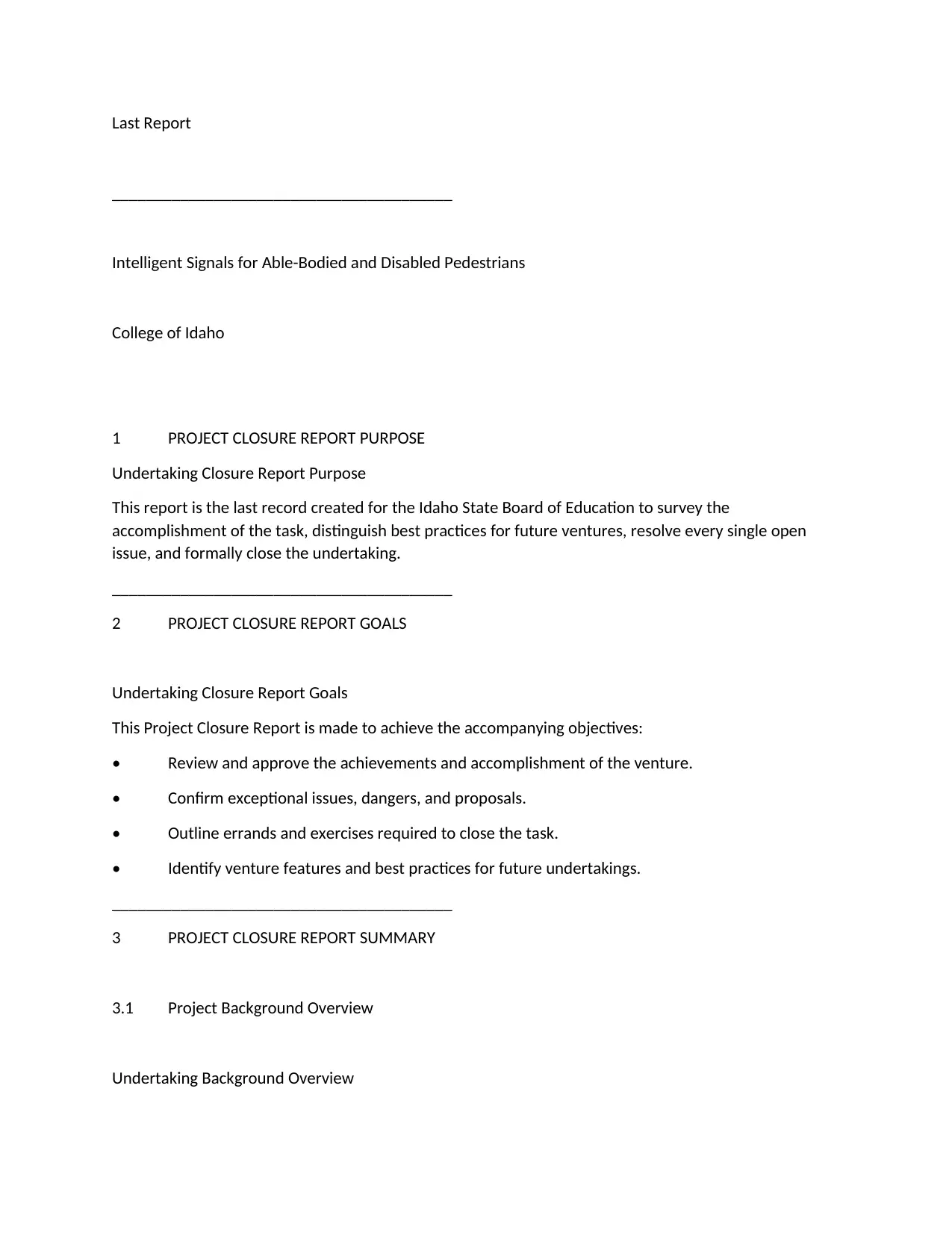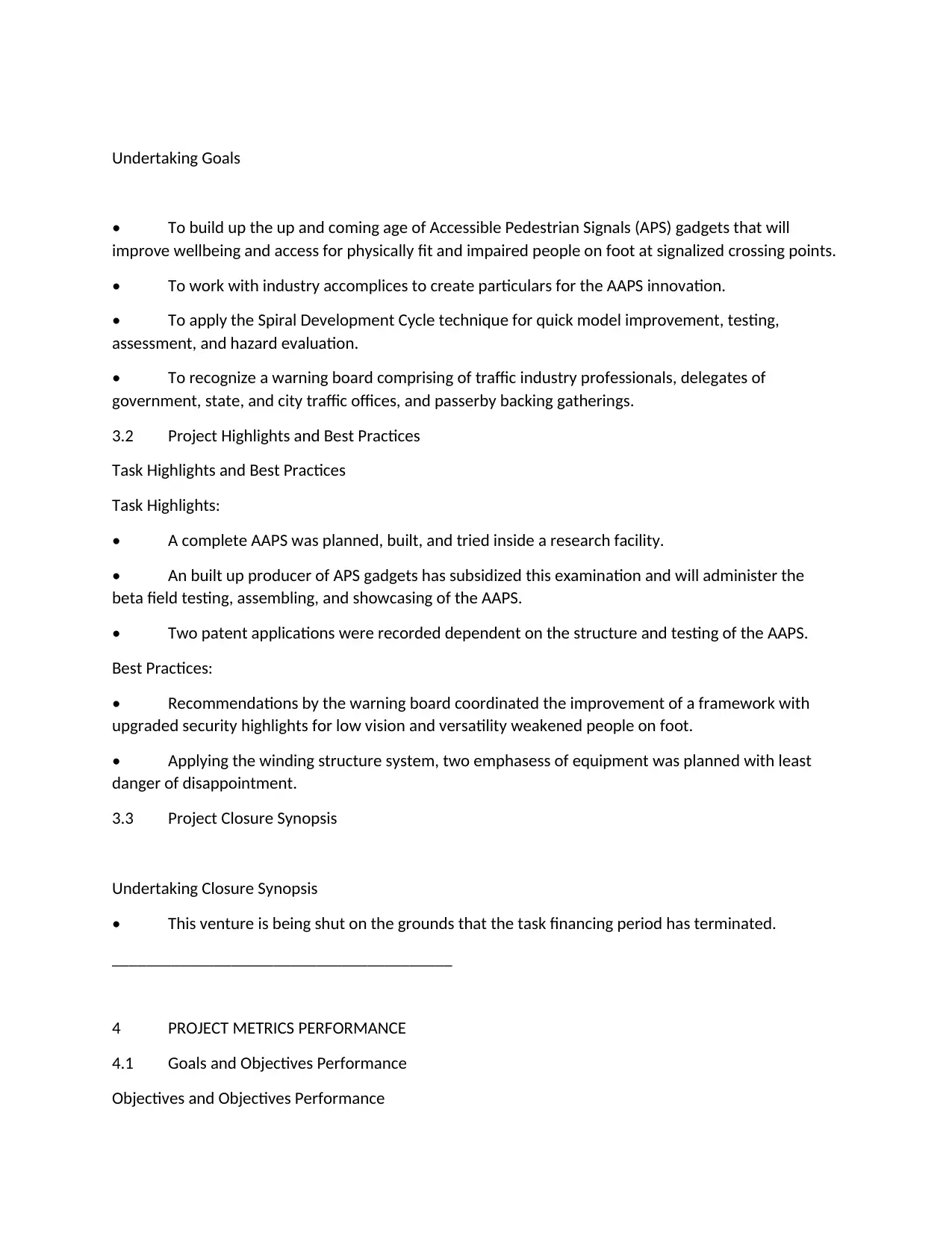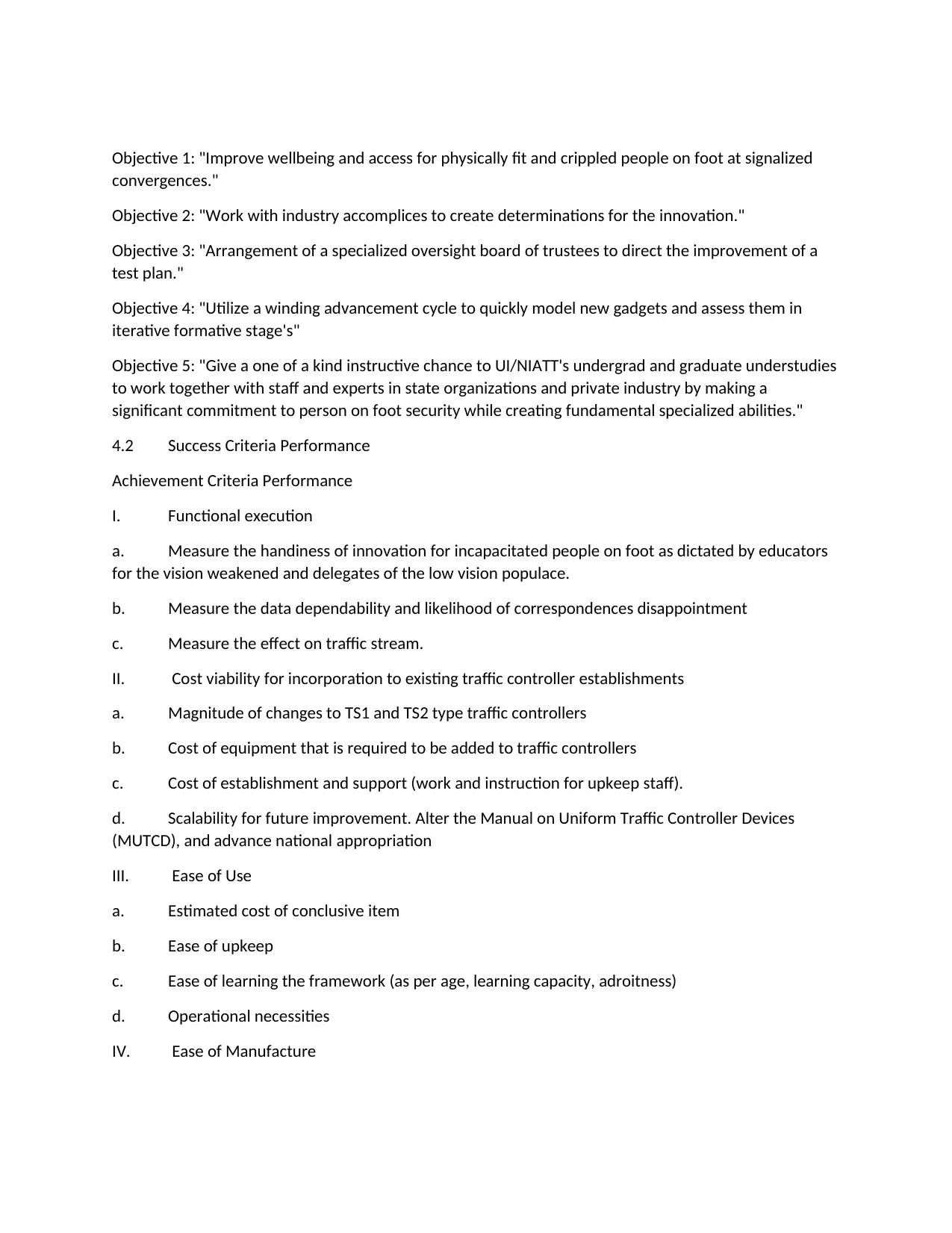College of Idaho: Intelligent Signals Project Closure Report
VerifiedAdded on 2022/11/24
|5
|1235
|397
Report
AI Summary
The provided document is a comprehensive project closure report for the "Intelligent Signals for Able-Bodied and Disabled Pedestrians" project. It details the project's purpose, goals, and achievements, including the development of Accessible Pedestrian Signals (APS) to enhance safety at signalized intersections. The report outlines the project's background, highlights, and best practices, such as utilizing a spiral development cycle and incorporating recommendations from a technical oversight board. It also covers project metrics, performance against objectives, success criteria, milestones, and deliverables, including the design of an open walker system using Ethernet communications and the involvement of industry partners and patent applications. The report concludes with a project closure synopsis, indicating that the project's funding period has ended.

Last Report
________________________________________
Intelligent Signals for Able-Bodied and Disabled Pedestrians
College of Idaho
1 PROJECT CLOSURE REPORT PURPOSE
Undertaking Closure Report Purpose
This report is the last record created for the Idaho State Board of Education to survey the
accomplishment of the task, distinguish best practices for future ventures, resolve every single open
issue, and formally close the undertaking.
________________________________________
2 PROJECT CLOSURE REPORT GOALS
Undertaking Closure Report Goals
This Project Closure Report is made to achieve the accompanying objectives:
• Review and approve the achievements and accomplishment of the venture.
• Confirm exceptional issues, dangers, and proposals.
• Outline errands and exercises required to close the task.
• Identify venture features and best practices for future undertakings.
________________________________________
3 PROJECT CLOSURE REPORT SUMMARY
3.1 Project Background Overview
Undertaking Background Overview
________________________________________
Intelligent Signals for Able-Bodied and Disabled Pedestrians
College of Idaho
1 PROJECT CLOSURE REPORT PURPOSE
Undertaking Closure Report Purpose
This report is the last record created for the Idaho State Board of Education to survey the
accomplishment of the task, distinguish best practices for future ventures, resolve every single open
issue, and formally close the undertaking.
________________________________________
2 PROJECT CLOSURE REPORT GOALS
Undertaking Closure Report Goals
This Project Closure Report is made to achieve the accompanying objectives:
• Review and approve the achievements and accomplishment of the venture.
• Confirm exceptional issues, dangers, and proposals.
• Outline errands and exercises required to close the task.
• Identify venture features and best practices for future undertakings.
________________________________________
3 PROJECT CLOSURE REPORT SUMMARY
3.1 Project Background Overview
Undertaking Background Overview
Secure Best Marks with AI Grader
Need help grading? Try our AI Grader for instant feedback on your assignments.

Undertaking Goals
• To build up the up and coming age of Accessible Pedestrian Signals (APS) gadgets that will
improve wellbeing and access for physically fit and impaired people on foot at signalized crossing points.
• To work with industry accomplices to create particulars for the AAPS innovation.
• To apply the Spiral Development Cycle technique for quick model improvement, testing,
assessment, and hazard evaluation.
• To recognize a warning board comprising of traffic industry professionals, delegates of
government, state, and city traffic offices, and passerby backing gatherings.
3.2 Project Highlights and Best Practices
Task Highlights and Best Practices
Task Highlights:
• A complete AAPS was planned, built, and tried inside a research facility.
• An built up producer of APS gadgets has subsidized this examination and will administer the
beta field testing, assembling, and showcasing of the AAPS.
• Two patent applications were recorded dependent on the structure and testing of the AAPS.
Best Practices:
• Recommendations by the warning board coordinated the improvement of a framework with
upgraded security highlights for low vision and versatility weakened people on foot.
• Applying the winding structure system, two emphasess of equipment was planned with least
danger of disappointment.
3.3 Project Closure Synopsis
Undertaking Closure Synopsis
• This venture is being shut on the grounds that the task financing period has terminated.
________________________________________
4 PROJECT METRICS PERFORMANCE
4.1 Goals and Objectives Performance
Objectives and Objectives Performance
• To build up the up and coming age of Accessible Pedestrian Signals (APS) gadgets that will
improve wellbeing and access for physically fit and impaired people on foot at signalized crossing points.
• To work with industry accomplices to create particulars for the AAPS innovation.
• To apply the Spiral Development Cycle technique for quick model improvement, testing,
assessment, and hazard evaluation.
• To recognize a warning board comprising of traffic industry professionals, delegates of
government, state, and city traffic offices, and passerby backing gatherings.
3.2 Project Highlights and Best Practices
Task Highlights and Best Practices
Task Highlights:
• A complete AAPS was planned, built, and tried inside a research facility.
• An built up producer of APS gadgets has subsidized this examination and will administer the
beta field testing, assembling, and showcasing of the AAPS.
• Two patent applications were recorded dependent on the structure and testing of the AAPS.
Best Practices:
• Recommendations by the warning board coordinated the improvement of a framework with
upgraded security highlights for low vision and versatility weakened people on foot.
• Applying the winding structure system, two emphasess of equipment was planned with least
danger of disappointment.
3.3 Project Closure Synopsis
Undertaking Closure Synopsis
• This venture is being shut on the grounds that the task financing period has terminated.
________________________________________
4 PROJECT METRICS PERFORMANCE
4.1 Goals and Objectives Performance
Objectives and Objectives Performance

Objective 1: "Improve wellbeing and access for physically fit and crippled people on foot at signalized
convergences."
Objective 2: "Work with industry accomplices to create determinations for the innovation."
Objective 3: "Arrangement of a specialized oversight board of trustees to direct the improvement of a
test plan."
Objective 4: "Utilize a winding advancement cycle to quickly model new gadgets and assess them in
iterative formative stage's"
Objective 5: "Give a one of a kind instructive chance to UI/NIATT's undergrad and graduate understudies
to work together with staff and experts in state organizations and private industry by making a
significant commitment to person on foot security while creating fundamental specialized abilities."
4.2 Success Criteria Performance
Achievement Criteria Performance
I. Functional execution
a. Measure the handiness of innovation for incapacitated people on foot as dictated by educators
for the vision weakened and delegates of the low vision populace.
b. Measure the data dependability and likelihood of correspondences disappointment
c. Measure the effect on traffic stream.
II. Cost viability for incorporation to existing traffic controller establishments
a. Magnitude of changes to TS1 and TS2 type traffic controllers
b. Cost of equipment that is required to be added to traffic controllers
c. Cost of establishment and support (work and instruction for upkeep staff).
d. Scalability for future improvement. Alter the Manual on Uniform Traffic Controller Devices
(MUTCD), and advance national appropriation
III. Ease of Use
a. Estimated cost of conclusive item
b. Ease of upkeep
c. Ease of learning the framework (as per age, learning capacity, adroitness)
d. Operational necessities
IV. Ease of Manufacture
convergences."
Objective 2: "Work with industry accomplices to create determinations for the innovation."
Objective 3: "Arrangement of a specialized oversight board of trustees to direct the improvement of a
test plan."
Objective 4: "Utilize a winding advancement cycle to quickly model new gadgets and assess them in
iterative formative stage's"
Objective 5: "Give a one of a kind instructive chance to UI/NIATT's undergrad and graduate understudies
to work together with staff and experts in state organizations and private industry by making a
significant commitment to person on foot security while creating fundamental specialized abilities."
4.2 Success Criteria Performance
Achievement Criteria Performance
I. Functional execution
a. Measure the handiness of innovation for incapacitated people on foot as dictated by educators
for the vision weakened and delegates of the low vision populace.
b. Measure the data dependability and likelihood of correspondences disappointment
c. Measure the effect on traffic stream.
II. Cost viability for incorporation to existing traffic controller establishments
a. Magnitude of changes to TS1 and TS2 type traffic controllers
b. Cost of equipment that is required to be added to traffic controllers
c. Cost of establishment and support (work and instruction for upkeep staff).
d. Scalability for future improvement. Alter the Manual on Uniform Traffic Controller Devices
(MUTCD), and advance national appropriation
III. Ease of Use
a. Estimated cost of conclusive item
b. Ease of upkeep
c. Ease of learning the framework (as per age, learning capacity, adroitness)
d. Operational necessities
IV. Ease of Manufacture

a. Direct cost of materials and creation
b. Maturity of innovations
c. Cost of advertising
4.3 Milestone and Deliverables Performance
Achievement and Deliverables Performance
Objective 1: another plan for an open walker framework (APS) that utilizes Ethernet interchanges to
execute an appropriated control framework. Present APS plans speak to a danger factor by APS
frameworks having imperceptible disappointment modes that may play erroneous capable of being
heard messages. The report portrays an appropriated control framework that utilizes Ethernet
interchanges over electrical cables.
The frameworks comprises of a controller unit housed in the rush hour gridlock controller bureau and
interfaces to existing National Electrical Manufacturers Association (NEMA) TS1 and TS2 traffic controller
cupboards at the field terminals. It bolsters from one to 16 person on foot stations. The controller unit
utilizes a Linux based single board PC with double Ethernet ports. The person on foot stations utilized an
asset rich NXP processor lessening the quantity of segments and size of circuit board.
All arrangement and diagnostics is practiced utilizing a PC with a standard internet browser and an
Ethernet association. This interface diminishes the size and cost of the unit mounted in the controller
bureau. The website page gives ongoing status of all controller inputs and the condition of every single
passerby station and the sound message as of now being played.
Straightforward Network Management Protocol (SNMP) and Simple Transport Management Protocol
(STMP) custom items are utilized so that every correspondence exchange is confirmed. A system
convention is executed that pursues the rules for National Transportation Communications for
Intelligent Transportation Systems Protocol (NTCIP) custom articles.
Objective 2: During the examination time frame, we collected a specialized oversight warning load up
comprising of agents from industry, government, and backing bunches for the impaired. Campbell
Company of Boise, Idaho gave an extra $61,535 subsidizing to build up the Advanced Accessible
Pedestrian Signals (AAPS).
Amid the mid year of 2009, a University of Idaho Electrical Engineering graduate understudy worked in
the Campbell Company producing office in Boise, ID to aid the exchange of innovation from the
University of Idaho examine labs to industry. Assembling of the AAPS was started in August 2009.
The utilization of two licenses relating straightforwardly to the AAPS frameworks was finished in March
and August 2009. Walk 25, 2009, U.S. Patent Application No. 12/411,306 "Progressed Accessible
Pedestrian Control System for the Physically Disabled" was documented on the sake of Richard Wall and
Gabriel DeRuwe. The August patent was a joint application between University of Idaho scientists and
Campbell Company originators. (UP Patent Application #7832-8344901, "Progressed Accessible
Pedestrian System for Signalized Traffic Intersections" August 19, 2009).
b. Maturity of innovations
c. Cost of advertising
4.3 Milestone and Deliverables Performance
Achievement and Deliverables Performance
Objective 1: another plan for an open walker framework (APS) that utilizes Ethernet interchanges to
execute an appropriated control framework. Present APS plans speak to a danger factor by APS
frameworks having imperceptible disappointment modes that may play erroneous capable of being
heard messages. The report portrays an appropriated control framework that utilizes Ethernet
interchanges over electrical cables.
The frameworks comprises of a controller unit housed in the rush hour gridlock controller bureau and
interfaces to existing National Electrical Manufacturers Association (NEMA) TS1 and TS2 traffic controller
cupboards at the field terminals. It bolsters from one to 16 person on foot stations. The controller unit
utilizes a Linux based single board PC with double Ethernet ports. The person on foot stations utilized an
asset rich NXP processor lessening the quantity of segments and size of circuit board.
All arrangement and diagnostics is practiced utilizing a PC with a standard internet browser and an
Ethernet association. This interface diminishes the size and cost of the unit mounted in the controller
bureau. The website page gives ongoing status of all controller inputs and the condition of every single
passerby station and the sound message as of now being played.
Straightforward Network Management Protocol (SNMP) and Simple Transport Management Protocol
(STMP) custom items are utilized so that every correspondence exchange is confirmed. A system
convention is executed that pursues the rules for National Transportation Communications for
Intelligent Transportation Systems Protocol (NTCIP) custom articles.
Objective 2: During the examination time frame, we collected a specialized oversight warning load up
comprising of agents from industry, government, and backing bunches for the impaired. Campbell
Company of Boise, Idaho gave an extra $61,535 subsidizing to build up the Advanced Accessible
Pedestrian Signals (AAPS).
Amid the mid year of 2009, a University of Idaho Electrical Engineering graduate understudy worked in
the Campbell Company producing office in Boise, ID to aid the exchange of innovation from the
University of Idaho examine labs to industry. Assembling of the AAPS was started in August 2009.
The utilization of two licenses relating straightforwardly to the AAPS frameworks was finished in March
and August 2009. Walk 25, 2009, U.S. Patent Application No. 12/411,306 "Progressed Accessible
Pedestrian Control System for the Physically Disabled" was documented on the sake of Richard Wall and
Gabriel DeRuwe. The August patent was a joint application between University of Idaho scientists and
Campbell Company originators. (UP Patent Application #7832-8344901, "Progressed Accessible
Pedestrian System for Signalized Traffic Intersections" August 19, 2009).
Secure Best Marks with AI Grader
Need help grading? Try our AI Grader for instant feedback on your assignments.

Objective 3: Based upon the proposal from three gatherings of our warning board that shaped out
specialized oversight council (ToC), we indicated, created, assessed, and surveyed two usage for an
AAPS.
specialized oversight council (ToC), we indicated, created, assessed, and surveyed two usage for an
AAPS.
1 out of 5
Your All-in-One AI-Powered Toolkit for Academic Success.
+13062052269
info@desklib.com
Available 24*7 on WhatsApp / Email
![[object Object]](/_next/static/media/star-bottom.7253800d.svg)
Unlock your academic potential
© 2024 | Zucol Services PVT LTD | All rights reserved.